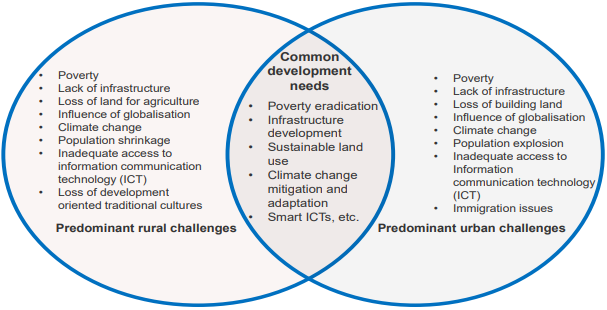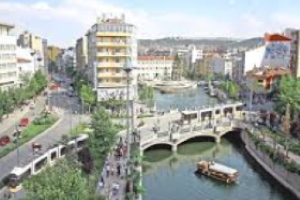Working Group 8.1
Rural – urban dependency
Introduction
Rural and urban (including peri-urban) areas are important for
development, because all over the world they provide space for people to
live. They face similar development challenges, although differences exist
as well, and therefore have common needs in terms of development (Figure).

Figure: Challenges and common needs of rural and
urban areas
Both rural and urban areas co-exist for mutual benefits because rural
resources are needed in urban areas and urban resources are needed in rural
areas. There has been a big focus on urban development – especially
concerning the development of sustainable, green and smart cities – with
less attention paid to rural development. While the focus on urbanisation is
understandable, spatial planning (and development) demands a balance (and
continuum) between rural and urban development. From this perspective, rural
areas deserve similar attention for them to become more liveable places.
With appropriate spatial planning (and development) concepts and approaches,
rural and urban areas can become socially and technologically smart spatial
units. However, this is only possible if they are investigated from a
continuum lens – with focus on their socio-spatial interdependencies and
interrelationships.
Policy Issues
- Investigate rural – urban relations and dependencies that affect
sustainable spatial development.
- Identify key developments in rural areas, such as depopulation,
rural land market or food security, to be addressed in a SMART way.
- Investigate approaches to urban and rural development and
recommend or innovate approaches that are responsive to the
urban-rural continuum of development.
Chair
Rosy Liao Rong, People’s Republic of China
rosyliao[at]outlook.com
Dr.-Ing. Michael Klaus, Germany
klaus[at]hss.de
Mr. Eugene Chigbu, Germany
ue.chigbu[at]tum.de
What we are working on -
- Identify factors and delineate solutions for SMART
rural development to minimize the gap between urban and
rural areas.
- Working paper on SMART rural areas (in collaboration
with GLTN).
|
 |
What's New
Focus: Rural-urban relations and their dependencies to foster smart and
sustainable spatial developments in the urban-rural continuum.

|




